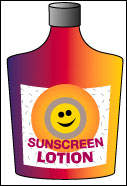
P.O. Box 189, Moffett Field, CA 94035-0189
 |
||||||||
| Issue Number 226 |
April
1998
|
|||||||
|
P.O. Box 189, Moffett Field, CA 94035-0189 |
||||||||
|
|
||||||||
Blossom by blossom the spring begins--and bursts forth into allergies, sniffles, and the last flushes of flu across the land. Several ASRS reporters affected by these and other seasonal maladies share their stories of how the autopilot played a (mostly) saving role in their flights. We begin with an air taxi pilot’s drowsy experience aloft.
This reporter was lucky that ATC didn't get upset over the unauthorized penetration of Class B and D airspace. His remedy is on target, and we hope he and others will practice it in the future.
 A
General Aviation pilot sensitive to sun exposure took the precaution
of applying a sunscreen lotion before flying over a desert area. But
as the cockpit became warm, he started to perspire. Then began a horrific
experience:
A
General Aviation pilot sensitive to sun exposure took the precaution
of applying a sunscreen lotion before flying over a desert area. But
as the cockpit became warm, he started to perspire. Then began a horrific
experience:
During a callback conversation with an ASRS analyst, the reporter stated that when the sunscreen lotion ran into his eyes, he experienced sharp pains and loss of vision in both eyes. Fortunately, he was able to put the aircraft on autopilot. The reporter recalled that he had placed a can of soda in the cockpit. He managed to find the soda and pour it on one eye, while wiping the eye with a tissue until it became usable. He ran out of soda, but then saw a container of water, which he used to clean the other eye. After he had recovered his sight, he checked his position and discovered that he had overflown a turn point and was now inside a Restricted Area. He called the Center controller, who vectored him clear and on course.
According to the reporter, on the back of the sunscreen container--in fine print--was a warning to avoid eye contact with the contents. He told ASRS that he remembered reading the warning before the flight, but never considered the possibility of perspiration causing eye contact with the sunscreen lotion ingredients. The reporter felt that there should be a stronger and more complete warning on the container. He knew of another pilot who had a similar experience, using the same sunscreen lotion.
Schnooked by the Schnozzle
The late Jimmy ("The Schnozz") Durante might have appreciated this report from a Captain with a new First Officer on board, who found that sneezing at the wrong time had unforeseen consequences:
The autopilot was unfortunately disengaged before the Captain's "nose over," which led to the altitude bust and traffic conflict.
"...And I was the April Fool"
A report from a Captain having a really bad day:
SID Issues in International Flights
U.S. flight crews operating outside the country often face a number of different operating procedures. A frequent subject of ASRS reports involving foreign locations is the misreading of arrival or departure procedures, especially when the chart depictions are similar. An example reported to ASRS is the similarity between four SIDs for Frankfurt, Germany. Although the names and numbers of the SIDs have changed since the following report was submitted, the issue is still relevant. Here, the Captain of a widebody jet made the assumption that the two Runway 7 SIDs would have the same ground track, just as the two Runway 25 SIDs did.
Since the SID graphic and accompanying descriptive text may not be on the same page, thorough review of charts and their related text is the best defense against deviations from published departure procedures.
Last Tango in Zurich
Misunderstanding of clearances and instructions is a common problem for English-speaking crews operating in countries where English is not the native language, as another Captain reports:
The crew apparently started to follow these instructions, turning north toward TANGO after the VOR. Then...
The Controller gave us a vector, and said we were supposed to go to ALAGO, then TANGO [that is, further east before turning north]. What he had really said [in the new clearance] was, "ZURICH, ALAGO, TANGO," not "ZURICH, and out to TANGO."
The clearance as the crew understood it was not in accordance with the published procedure, which should have been a heads-up to question ATC about the instructions. Following the incorrect headings, particularly in IMC, could have put the flight at an unsafe altitude in this mountainous terrain.
The Transition Altitude Challenge
Outside North America, the altitude at which pilots transition from indicated altitude to pressure altitude is variable. Above this Transition Altitude, the term "Flight Level" (FL) is used. In most of Europe, the Transition Altitude is between 4,000 and 6,000 feet MSL, but in some areas, it ranges from as low as 3,000 to as high as 7,000 feet.
In the following report from an air carrier First Officer on a European flight, the unfamiliar, nonstandard Transition Altitude added to the distractions of an inexperienced crew attempting a very complicated departure procedure.
The reporter emphasizes that in the future, he will use the autopilot, especially when flying with crew members who are unfamiliar with this complex departure.
|
|
|---|
| Citation 750 inflight main gear door separation |
| Conflicting graphic and narrative for a Colorado SID |
| ATR-42 engine fire following ground propeller reversal |
| Gulfstream III equipment failure due to failed electrical relay |
| Airbus A-300 electrical failure attributed to an APU overload |
|
|
|
|---|---|
| Air Carrier Pilots | 1,636 |
| General Aviation Pilots | 659 |
| Controllers | 68 |
| Cabin/Mechanics/Military/Other | 70 |
| TOTAL | 2,433 |